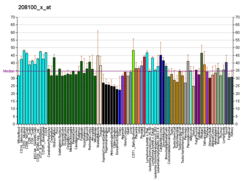| SEMA6C |
|---|
|
| Identifiers |
|---|
| Aliases | SEMA6C, SEMAY, m-SemaY, m-SemaY2, semaphorin 6C, Sema-Y |
|---|
| External IDs | OMIM: 609294; MGI: 1338032; HomoloGene: 7931; GeneCards: SEMA6C; OMA:SEMA6C - orthologs |
|---|
| Gene location (Human) |
|---|
 | | Chr. | Chromosome 1 (human)[1] |
|---|
| | Band | 1q21.3 | Start | 151,131,685 bp[1] |
|---|
| End | 151,146,631 bp[1] |
|---|
|
| Gene location (Mouse) |
|---|
 | | Chr. | Chromosome 3 (mouse)[2] |
|---|
| | Band | 3|3 F2.1 | Start | 95,160,457 bp[2] |
|---|
| End | 95,174,024 bp[2] |
|---|
|
| RNA expression pattern |
|---|
| Bgee | | Human | Mouse (ortholog) |
|---|
| Top expressed in | - muscle of thigh
- apex of heart
- gastrocnemius muscle
- right hemisphere of cerebellum
- right testis
- ganglionic eminence
- left testis
- Skeletal muscle tissue of rectus abdominis
- triceps brachii muscle
- left ventricle
|
| | Top expressed in | - muscle of thigh
- triceps brachii muscle
- temporal muscle
- sternocleidomastoid muscle
- spermatocyte
- vastus lateralis muscle
- intercostal muscle
- pyloric antrum
- tibialis anterior muscle
- ankle
|
| | More reference expression data |
|
|---|
| BioGPS |  | | More reference expression data |
|
|---|
|
| Gene ontology |
|---|
| Molecular function | - semaphorin receptor binding
- chemorepellent activity
- neuropilin binding
| | Cellular component | - integral component of membrane
- plasma membrane
- membrane
- integral component of plasma membrane
- cytoplasm
- cell surface
- extracellular space
| | Biological process | - multicellular organism development
- cell differentiation
- nervous system development
- axon guidance
- negative regulation of axon extension
- neural crest cell migration
- positive regulation of cell migration
- negative regulation of axon extension involved in axon guidance
- negative chemotaxis
- semaphorin-plexin signaling pathway
| | Sources:Amigo / QuickGO |
|
| Orthologs |
|---|
| Species | Human | Mouse |
|---|
| Entrez | | |
|---|
| Ensembl | | |
|---|
| UniProt | | |
|---|
| RefSeq (mRNA) | |
|---|
NM_001178061
NM_001178062
NM_030913 |
| |
|---|
| RefSeq (protein) | |
|---|
NP_001171532
NP_001171533
NP_112175 |
| |
|---|
| Location (UCSC) | Chr 1: 151.13 – 151.15 Mb | Chr 3: 95.16 – 95.17 Mb |
|---|
| PubMed search | [3] | [4] |
|---|
|
| Wikidata |
| View/Edit Human | View/Edit Mouse |
|
















